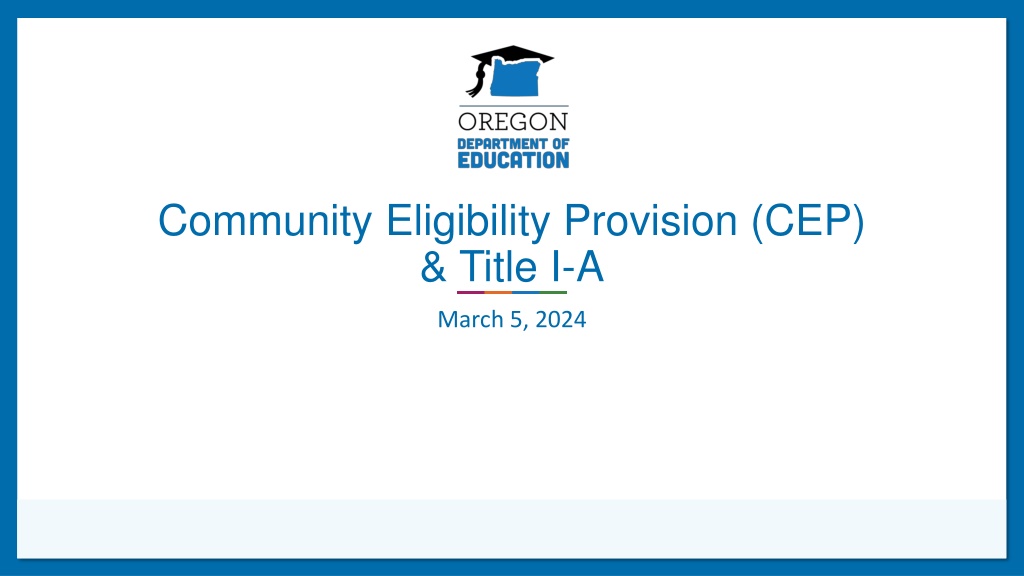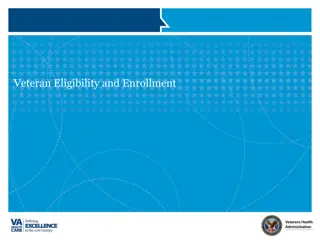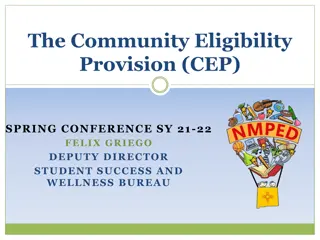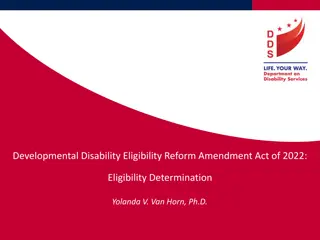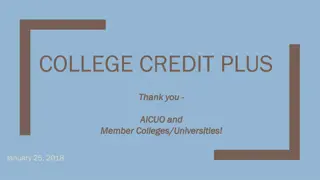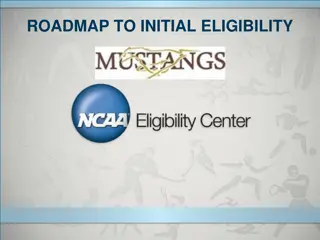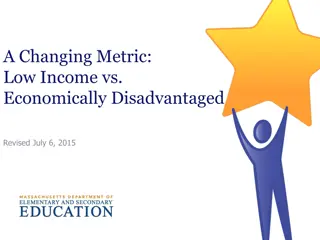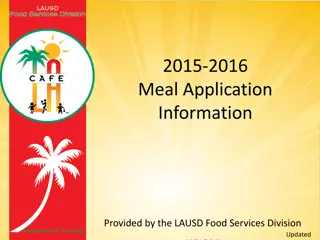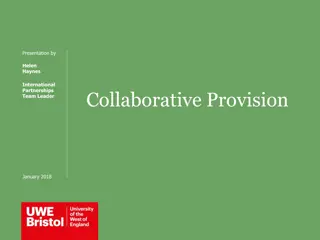Community Eligibility Provision (CEP) and Title I-A
Community Eligibility Provision (CEP) is a meal service option for schools and districts that eliminates household applications, decreases administrative burden, increases student participation, reduces stigma, and improves program efficiency. CEP connects with Title I-A to provide all children with a fair, equitable, and high-quality education, aiming to close educational achievement gaps by supporting districts and schools serving children from families experiencing poverty.
Download Presentation

Please find below an Image/Link to download the presentation.
The content on the website is provided AS IS for your information and personal use only. It may not be sold, licensed, or shared on other websites without obtaining consent from the author.If you encounter any issues during the download, it is possible that the publisher has removed the file from their server.
You are allowed to download the files provided on this website for personal or commercial use, subject to the condition that they are used lawfully. All files are the property of their respective owners.
The content on the website is provided AS IS for your information and personal use only. It may not be sold, licensed, or shared on other websites without obtaining consent from the author.
E N D
Presentation Transcript
Community Eligibility Provision (CEP) & Title I-A March 5, 2024
Outcomes for Today What is the Community Eligibility Provision (CEP)? How does CEP connect with Title I-A? Ranking and Serving Schools Resources Oregon Department of Education 2
A meal service option for schools and school districts CEP: Eliminates household applications Decreases administrative burden Increases student participation Reduces stigma Improves program efficiency Community Eligibility Provision Source: Planning & Implementation Guidance, p.8, Benefits of CEP Oregon Department of Education 3
Qualifying Criteria Participate in both the NSLP and SBP Submit enrollment data as of April 1 of the SY prior to starting CEP 25% or more identified students : Directly Certified for: SNAP, TANF, Medicaid (Free), Foster Participating in: Head Start / Early Head Start Qualifying Children: Oregon Pre-K, Preschool Promise Other Categorically Eligible: Homeless, Runaway, Migrant, Foster, FDPIR, Non-applicant students approved by local education officials Oregon Department of Education 4
Identified Student Percentage (ISP) Direct Certification Match Identified Students Total Students ISP Other Categorically Eligible All enrolled students Oregon Department of Education 5
The 1.6 Multiplier ISP x 1.6 is representative of Free and Reduced Applications Federal Free Claiming Percentage Applied to the: Site ISP Group ISP District ISP Oregon Department of Education 6
CEP and Title I-A Oregon Department of Education 7
Purpose of Title I-A The purpose of Title I, Part A is a to provide all children significant opportunity to receive a fair, equitable, and high-quality education, and to close educational achievement gaps. The goal is to address opportunity gaps that some students experience by providing resources to districts and schools who serve a larger population of children from families experiencing poverty. 8 Oregon Department of Education
What does CEP have to do with Title I-A? Rank and Serve is the process used to determine which schools should be served with Title I-A funds Districts must identify a consistent measure across schools to determine the number of students experiencing poverty CEP can be used as a metric for this purpose Oregon Department of Education 9
Selecting Measures of Poverty 1. Free and reduced-price lunch count or Community Eligibility Provision (CEP) data 2. Count of students receiving assistance under Temporary Assistance for Needy Families (TANF) 3. Count of student eligible for Medicaid (Oregon Health Plan) 4. Census counts of children from families below the poverty level (SAIPE) 5. A combination of two or more of these data sources Oregon Department of Education 10
Did you know participation in CEP does not impact a school district s Title I-A funding? I-A allocations are based on census poverty (SAIPE) data and come directly from USED participation in CEP does not mean that 100% of students are experiencing poverty? All students receive free meals, but the ISP represents the school s poverty percentage district CEP data can be accessed on the Special Provisions webpage? An updated list will be posted in mid-March Oregon Department of Education 11
When all schools in the district are CEP Option 1: Use the number of identified eligible students in each school Option 2: Use the number of identified eligible students in each school times the multiplier (1.6) Oregon Department of Education 12
When only some schools in the district are CEP Option 1: Use the number of eligible students in both CEP and non-CEP schools CEP Schools Option 2: Apply the 1.6 multiplier to the number of identified eligible students in both CEP and non- CEP schools Option 3: Use the number of identified eligible students times the multiplier (1.6) and use the free and reduced-price meal data for non-CEP schools Non-CEP Schools Oregon Department of Education 13
What about Oregons new poverty definition? Oregon Department of Education 14
Redefining Economically Disadvantaged The new definition is NOT: The new definition IS: Related to CEP eligibility Used for reporting student outcomes under SSA and ESSA A combination of five data components: Used for SSF determinations Used to determine district allocations under Title I-A TANF + SNAP + FC + MV + Migrant Students Experiencing Poverty Oregon Department of Education 15
Key Takeaways CEP removes barriers, decreases burden, and increases participation CEP data can be used as part of the rank and serve process for Title I-A Participation in CEP does not impact district Title I-A allocations Oregon Department of Education 16
Resources CEP Fact Sheet (USDA) Within District Allocations under Title I-A (USED) CEP and Requirements under I-A (USED) CEP Planning & Implementation Guidance (USDA) Community Eligibility Resource Center (USDA) Special Provisions web page (Child Nutrition) ESSA Quick Reference Brief: CEP and Title I-A (ODE) Oregon Department of Education 17
Please reach out! Federal Systems Team Jen Engberg Jennifer.Engberg@ode.oregon.gov Child Nutrition Jon Mabale jon.mabale@ode.oregon.gov Michelle Fleener michelle.fleener@ode.oregon.gov Sarah Martin Sarah.Martin@ode.oregon.gov Lisa Plumb Lisa.Plumb@ode.oregon.gov Amy Tidwell Amy.Tidwell@ode.oregon.gov Oregon Department of Education 18
